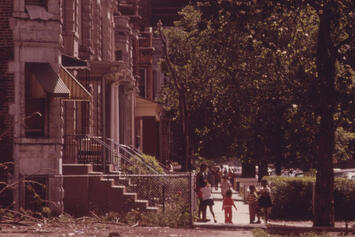
In 2020, U.S. cities experienced a 30% increase in homicides relative to 2019, with firearms becoming the leading cause of death for children, adolescents and young adults for the first time in our nation’s history. Since the darkest days of the pandemic and in the aftermath of George Floyd’s murder that summer, U.S. homicides have stabilized — and have recently begun to fall — but they continue to remain well above their pre-pandemic levels.
Despite the tumultuous years since the pandemic first turned up on our shores, it bears mentioning that national homicide rates remain well below their apex in 1990. However, this is not true in all communities. In a number of cities, including Chicago, homicide rates in the poorest communities are, in fact, higher than they were during the peak of the crack epidemic in the early 1990s. At the same time, because the recent increases in violence have been intensively concentrated in the city’s most disadvantaged communities, the most affluent communities continue to remain historically safe.
In other words, national homicide rates tell us little about the actual risks faced by individuals living in our most vulnerable communities. For these people, appeals to national data which average homicides over all types of communities — urban and rural, affluent and poor alike — are not relevant, and, in fact, could be highly misleading. If we want to understand the experiences of the Americans whose lives are the most affected by violence, we need to zero in on the small number of neighborhoods in the small number of U.S. cities that are most exposed to endemic violence.
What sort of risks do people living in America’s most violent neighborhoods actually face? Along with our colleague, Alex Knorre, we sought to answer that question through an analysis of the death rates of young men, aged 20-29, living in some of the most disadvantaged urban neighborhoods in the United States. We did so by comparing detailed geographic data collected by local law enforcement agencies on the incidence and demography of gun violence with estimates of the demographic composition of ZIP codes from the U.S. Census. While the national homicide rate is approximately 6 per 100,000 residents — implying that the average American faces an annual murder risk of 1 in 17,000 — lethal violence is far higher in Chicago’s toughest neighborhoods. In the city’s West Side neighborhood of Garfield Park, from 2020 to 2021, among men aged 20-29, the annual risk of being shot was nearly 6%. Among the shooting victims who die, this translates to an annual risk of firearm death of approximately 1 in 67, a risk that is more than 250 times higher than that of the average American. It is a risk that is experienced by these men year after year, and which is therefore subject to the cruel mathematics of compounding.
A young man living in Garfield Park in 2020 or 2021 faced a risk of firearm homicide that was more than three times greater than the risk of all-cause combat death faced by soldiers who were deployed to Afghanistan.
In order to make better sense of these statistics, a couple of benchmarks may be helpful. Every year, U.S. demographers calculate life expectancy using an updated period life table, which documents the share of people who have reached a given age in the prior year but who did not survive to the current year. In technical terms, the life table reports age-specific death rates. On average, a 25-year-old man living in the United States has a 99.8% probability of living to see 26. It is not until their 60s that the average U.S. male faces a general mortality risk comparable to the risk of firearm homicide faced by young men in the most disadvantaged communities in Chicago. In short, young men in these communities have been fast-forwarded through the prime years of their life to face the same annual life expectancy as much older men.
Read the rest of this piece at Vital City.
Aaron Chalfin is an associate professor in the department of criminology at the University of Pennsylvania. He is also a senior fellow at the Niskanen Center, a faculty research fellow at the National Bureau of Economic Research and a research affiliate at the University of Chicago Crime Lab.
Brandon del Pozo is a policing, public health and criminal justice researcher. He served in the NYPD for 19 years and for four years as chief of police of Burlington, Vt.
Photo: U.S. National Archives via Flickr in Public Domain.













pervasive vs. lethal
are homicides really a good measure of the sort of street crime that most people have to fear?